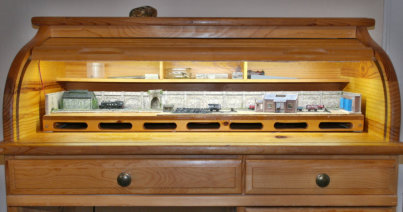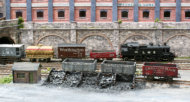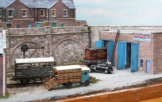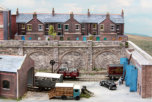
Archie’s Yard - Shunting Layout
This transition was aided by it conveniently fitting
inside the roll-top desk which is my work bench in the
living room.
Control of the locos is using the free open-source
Windows software JMRI DeCoder-Pro, running on a
laptop with the interface to the track via a USB
connection to a SPROG 3, which in turn generates the
DCC signals for the track.
The track is Peco Code-55. The points are operated
manually, from the rear, by rod-in-tube with micro-
switches to change frog polarity. All the points are the
short radius except for the double-slip at the center of
the layout which was a key component of the track
design for such a short space.
The length of the sector plate only allows a short goods
train comprising loco, three wagons and a guards van.
Archie’s Yard started out as a quick test bed and shunting
puzzle, as work on my main layout was suspended,
pending a move to a new house.
The layout is 36” by 10”. It has two hidden sidings at the
rear, linked with the front viewing section by a swiveling
sector plate and tunnel entrance.
The photograph on the right shows it in it’s original
unadorned form.
After the move, as relaxation from renovating an old
property, and before the main layout could be installed in
it’s room, Archie’s Yard gradually acquired bits of scenery
and then buildings, until it has become a finished model.
What’s a Shunting Puzzle?
A set of small cards depicts the wagons to be used and their destinations. These are drawn at random to make up a train which must be marshaled in the hidden sidings and brought to the visible section via the sector plate. There are a few rules though. When it enters the visible section the loco must be in front and a guards van must be at the rear of the train. Wagon movements within the yard do not need to have a guards van, and the sector plate track in the tunnel entrance will need to be used.
When the loco has delivered the wagons to their
destinations it must visit the engine shed for a quick
check-over and top-up with coal & water before getting
the wagons back to the hidden sidings. Again the loco
must lead the exit from the visible area and a goods van
must bring up the rear - sounds simple.
However there are a few snags; the loco has to get the
guards van out of the way before it can deliver the
wagons. Wagons have to be pushed into their
destination siding, otherwise the loco will be trapped in
the spur, and there is only room for the loco and two
wagons on the spur leading to the coal yard.



The standard couplings on the rolling stock have
been replaced with DG magnetically operated
couplings, magnets being buried at various
locations under the track; shown by blue dots in
the track plan above.
The two magnets at the sector plate end of the
hidden sidings are on a slide, so that they can be
positioned to not uncouple the train whilst being
pushed onto the sector plate.
Despite it’s small size, Archie’s Yard provides
interesting shunting challenges and demonstrates
that, with N Gauge, you do not need a large space
for an enjoyable layout.
The buildings are shown in more
detail on the page:
The low relief buildings along the
back will eventually be used on the
main Rowandale layout.
The trees have heather twigs for
their trunks and branches, with
foliage from Woodland Scenics.
This gallery shows Views of Archie’s Yard.











































